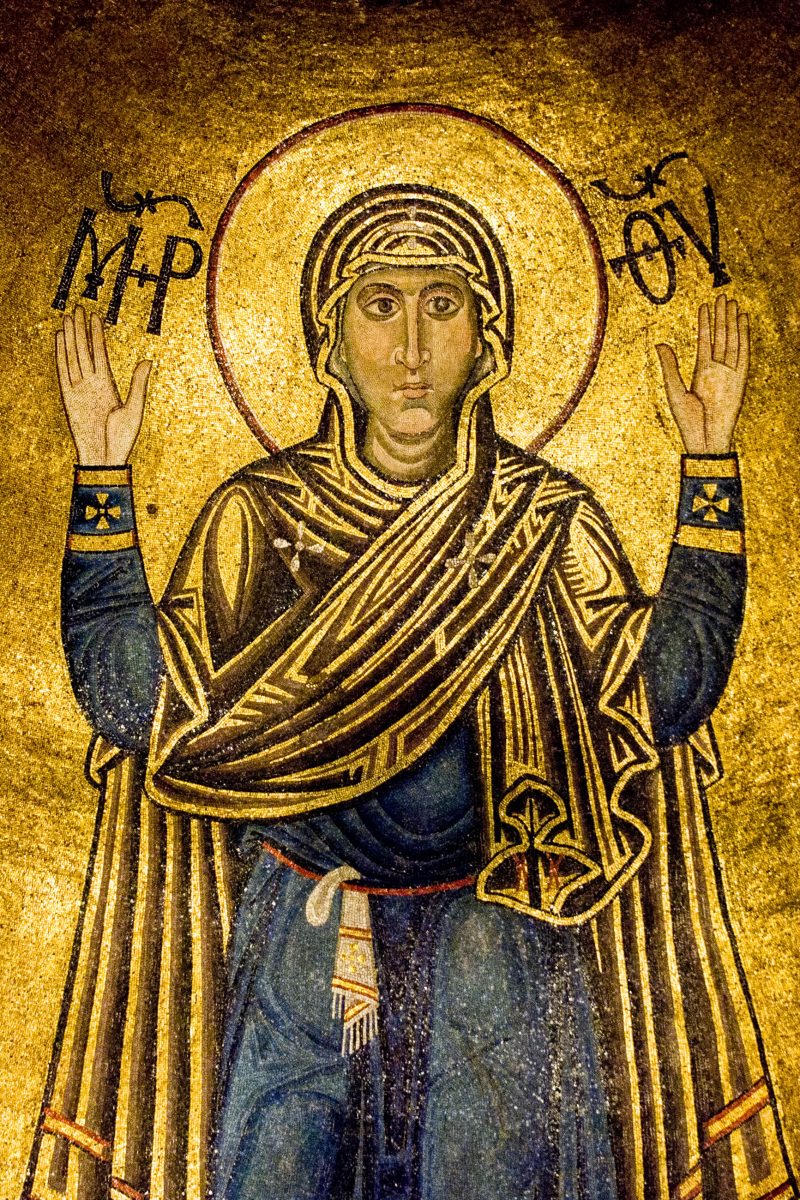Die Sophienkathedrale in Kiew gilt als absolutes Meisterwerk der christlichen Kunst in Europa. Während die Außenmauern der Kathedrale stark beschädigt und umgebaut wurden, blieb das prachtvolle byzantinische Interieur der Kathedrale aus dem 11. Jahrhundert zum Großteil erhalten.
Die Sophienkathedrale in der ukrainischen Hauptstadt Kiew gilt als Meisterwerk der christlichen Baukunst in Europa. 1990 wurde sie in die Weltkulturerbe-Liste der UNESCO aufgenommen und 2007 zu einem der Sieben Weltwunder der Ukraine erklärt. Ein Sprichwort sagt: Wer die Sophienkathedrale nicht gesehen hat, hat Kiew nie richtig kennengelernt.
Inhaltsverzeichnis
BILDER: Sophienkathedrale in Kiew
Der Bau der Sophienkathedrale wurde im Jahr 1037 begonnen, nachdem ein Jahr zuvor die Petschenegen vom Kiewer Fürst Jaroslaw, der Weise besiegt wurden. Sein Sarkophag aus weißem Marmor ist bis heute in der Kathedrale erhalten. Der ursprüngliche Bau im 11. Jahrhundert war bereits prachtvoll und maß knapp 40m Länge, 55m Breite und knapp 30m Höhe. Als Vorbild für die Sophienkathedrale diente die Hagia Sophia im damaligen Konstantinopel, welche ja ursprünglich ebenfalls als christliche Kirche erbaut wurde.
Monumentale Bedeutung der Sophienkathedrale
Mit ihren prunkvollen sieben Kuppeln und dem fünfschiffigen Innenraum fungierte sie als Hauptkathedrale der Kiewer Rus, einem Großreich, das heute als Vorgänger der Staaten Russland, Weißrussland und Ukraine gilt. Sie sollte von der Weisheit des Christentums, daher auch Sophia, die Weise, als Namenspatronin, und der politischen Macht der Russen künden. In der monumentalen Sophienkathedrale wurden Könige gekrönt und bestattet und Staatsgäste empfangen. Die erste Bibliothek Kiews befand sich ebenfalls in der Sophienkathedrale.

Der Niedergang Kiews als wichtige Stadt Russlands und die Zerstörung der Sophienkathedrale begann Mitte des 13. Jahrhunderts mit dem Einfall der Mongolen, denen die Krimtataren nachfolgten. Bis zum 17. Jahrhundert wurde die Kathedrale immer stärker beschädigt, bis unter Petro Mohyla der erste Wiederaufbau in Angriff genommen wurde. Im Zuge dessen wurden die Außengalerien geschlossen, wodurch die Kirche heute noch voluminöser wirkt. Am byzantinischen Innenraum wurde jedoch kaum etwas verändert.
Erst Anfang des 18. Jahrhunderts nachdem die Sophienkathedrale 1697 einem Brand zum Opfer gefallen war, wurde die Kirche unter Zar Peter I. im ukrainischen Barockstil völlig neu aufgebaut. Aus dieser Zeit stammen ein weiteres Stockwerk, die sechs zusätzlichen dunkelgrünen Kuppeln in Birnenform, die Außenmauer, ein geistliches Seminar, das Südtor und das beheizbare Refektorium, die „warme Sophie“. Der imposante Glockenturm wurde ebenfalls auf eine Höhe von knapp 80m ausgebaut.
1934 wurde die Sophienkathedrale kurzfristig geschlossen und zum Museum umfunktioniert, nach dem Zerfall der Sowjetunion im Jahr 1991 jedoch wieder an die orthodoxe Kirche übergeben. Das Kiewer und das Moskauer Patriarchat konnten sich jedoch nicht einigen, wem die Kirche gehört und auch die ukrainisch-katholische Kirche erhob Ansprüche, sodass der Staat die Kathedrale erneut zum Museum machte.
Spektakuläres Interieur aus dem 11. Jahrhundert

Auch die atemberaubende Innenausstattung erfolgte nach byzantinischem Vorbild. Während von den Außenmauern der Kathedrale fast keine Originale übrig blieben, glänzt das Interieur der Sophienkathedrale heute noch durch den prachtvollen Wandschmuck von damals.
Weltweit einzigartige 3.000 Quadratmeter Fresken und 260 Quadratmeter Mosaiken in 177 Farbtönen können in der Sophienkathedrale bestaunt werden, von denen die berühmtesten die 6m hohe „Betende Gottesmutter“ und der „Pantokrator“ sind.
Weitere Kunstwerke zeigen Bibelszenen, die 12 Apostel, Kirchenoberhäupter und Soldaten. Der Hauptraum ist durch eine prachtvolle goldene Ikonenwand geschmückt, von denen jedoch nur mehr wenige Originale erhalten sind. Um ihrer Funktion als Museum gerecht zu werden, können im zweiten Stock weitere Mosaike und Fresken aus dem 12. Jahrhundert aus der Michaelskathedrale und eine 13 Tonnen schwere Glock aus Bronze aus dem Jahr 1705 besichtigt werden. Auch ein Modell von Kiew aus dem Mittelalter ist hier ausgestellt.
Weiterführende Links:
Info zu den Mosaiken und Fresken in der Sophienkathedrale in Kiew





